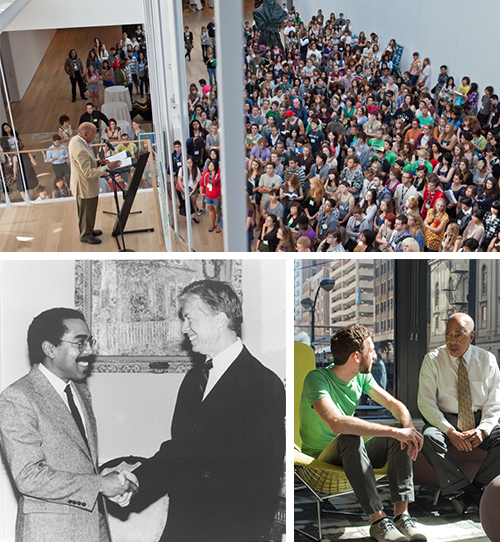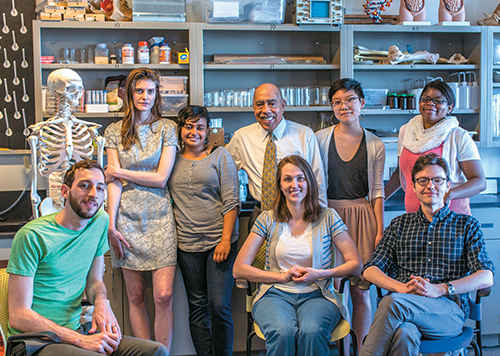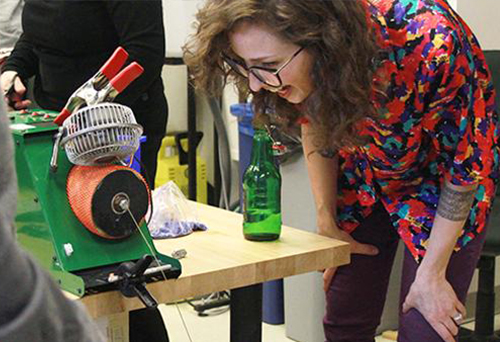
Portrait of Walter E. Massey. (Photo courtesy the School of the Art Institute of Chicago)
This article originally appeared in the 2016 issue of Inquiry, the annual publication produced for University of Chicago Physical Sciences Division alumni and friends.
Former Argonne director; UChicago VP of research, trustee, and now representative on the Giant Magellan Telescope board; physicist; and retiring art school president Walter E. Massey enters a new phase.
Often the question, “So what’s next for you?” comes at the end of a profile about a notable person leaving a prominent position. But for Walter E. Massey, who stepped down as the president of the School of the Art Institute of Chicago in June, the end of each career stage has been the beginning of something equally if not more remarkable.
Sitting in his eighth-floor office overlooking Millennium Park, three days before the end of his six-year term, Massey explains that he will remain as SAIC’s chancellor, participating in fundraising and outreach efforts. The part-time position grants him more time to participate as UChicago’s representative on the board of the Giant Magellan Telescope Organization, a consortium of about a dozen US and international institutions that oversees the construction and management of a super giant telescope in Chile’s Las Campanas Observatory. The segmented-mirror telescope, scheduled to be operational by 2022, promises to “if not answer, then shed light—no pun intended—on our biggest questions about the universe,” says Massey.

An emeritus trustee of the University since 2008, Massey joined the GMTO board in February, filling the spot vacated by Physical Sciences Division dean Rocky Kolb. Massey, a physicist with extensive advisory board experience—Bank of America, the Mellon Foundation, and the Marine Biological Laboratory, to name a few—has been affiliated with UChicago longer than with any other institution.
His wife, Shirley Anne Massey, has been involved with UChicago even longer. She grew up in Hyde Park, and her father was the first black janitor at the Laboratory Schools, says Massey. One son, Eric Massey, LAB’89, AB’94, who works in environmental research, has a daughter, Eva, enrolled at Lab. “Our family,” Walter Massey says, “is part of the UChicago community.”
Born in Hattiesburg, Mississippi, in 1938, Massey loved math and in the 10th grade was awarded a scholarship to Morehouse College in Atlanta. His parents believed education was essential, and Massey went into theoretical physics in part to rise above the discrimination of his childhood. As he told Physics Today in October 1990, “When you’re black and you grow up segregated, so much depends on how people think of you. In theoretical physics, no one reading your papers would know if you were black or white. There’s no such thing as black physics.”
After earning his PhD in physics from Washington University in St. Louis, he joined Argonne National Laboratory as a postdoc. “That was 1966,” says Massey. “Fifty years—my god!”

Starting in graduate school, Massey studied theoretical condensed matter physics—the study of solid-, liquid-, and plasma-state matter and the physical properties of each—focusing on the application of quantum theory to helium.
At Washington University and later as an assistant professor at the University of Illinois at Urbana-Champaign (UIUC) and a professor at Brown University, he studied superfluidity of liquid helium, which exhibits unusual properties such as frictionless flow and the apparent ability to defy gravity at extremely low temperatures.
While continuing the solitary endeavor of his research, Massey also turned his attention to broader interests, motivated by the 1960s civil rights movement to engage with society. He became a founding trustee of the Illinois Mathematics and Science Academy, a public high school for students interested in a science or math career. While at Brown he developed a program to educate future teachers for inner city schools and also served as dean of the college.
In 1979 Massey returned to Argonne—this time as director and UChicago professor of physics—now in a position to drive scientific discovery on a broader scale. Under Massey’s leadership Argonne developed a new technology for nuclear reactors, the Liquid Metal Reactor, which, he says, “may in fact be one of the technologies that comes back if nuclear power has a resurgence.” (He hopes it does.) The lab also developed what ultimately became the Advanced Photon Source, which provides ultra-bright, high-energy x-ray beams for research in almost all scientific disciplines.
In 1983 Massey was appointed UChicago’s vice president of research, cofounding and chairing the Argonne-Chicago Development Corporation—one of the first organizations in the country designed to commercialize academic research. The predecessor to such entities as UChicagoTech and the Polsky Center for Entrepreneurship and Innovation, ARCH “was unique and interesting,” Massey says, “in that it involved Argonne scientists and engineers, UChicago faculty from both science and business, graduate students, and trustees.”
“Back then the climate was not conducive to commercialization,” he says, noting that ARCH was formed not long after the 1980 passage of the Bayh-Dole Act, which granted universities and businesses exclusive control over government-funded inventions. “Now it’s taken for granted. Potential for commercialization is just part of young faculty’s career paths.”
Application not only connects the University to the world outside, he says, but also demonstrates that governmental investment in science and technology benefits the country’s economy. Well versed in how the government thinks about funding science, in 1991 Massey, a Democrat, was appointed by George H. W. Bush to be director of the National Science Foundation. He also served on the President’s Council of Advisors on Science and Technology for both George H. W. and George W. Bush.
While leading the NSF, Massey helped persuade Congress to fund what, in 1992, was the NSF’s single largest investment to date: the Laser Interferometer Gravitational-Wave Observatory. Designed to detect the gravitational waves predicted by Albert Einstein as part of his general theory of relativity, LIGO was a tough sell. Much of the astronomy community was opposed to it, arguing such waves couldn’t be detected by available—or even proposed—technology. Massey and LIGO’s leaders argued that both the science and technology that came from LIGO would benefit research beyond the search for gravitational waves.
It took 25 years, but LIGO finally detected the waves in September 2015 and again in December. Though he had been certain the project was a solid investment, Massey was still “dumbfounded” when he heard the news: “It’s one of those things—you wonder if it’ll ever happen.”
A lifelong advocate for science, Massey has also advocated for scientists themselves, in particular pushing for greater gender and racial equality in science, technology, engineering, and mathematical (STEM) fields. He believes one path to parity is mentorship, having benefited so greatly himself from mentors.
The only physics major in his class at Morehouse, he was mentored by Sabinus H. Christensen, a white professor at the historically black college who, says Massey, inspired a good proportion of black physicists to earn their doctorates—still a tiny percentage then. In a June 1992 article about Massey, Scientific American cites NSF data showing only 340 black PhDs in science and engineering out of 14,776 total in 1990. In that same article, Massey half jokingly says he used to give speeches urging universities to double their number of black PhDs, but because many had none, he changed his recommendation to “double plus one.”

A cofounder of the National Society of Black Physicists, Massey has long worked to encourage women and underrepresented minorities in STEM, founding outreach groups at UIUC and Brown, and later as provost and vice president of academic affairs at the University of California and then as president of his alma mater, Morehouse.
Over his career he’s seen “tremendous” progress, Massey says, “but still not enough.” While women have made great strides in representation, particularly in the biological sciences, “there’s still a great need to push these issues and provide funding, especially for African Americans and Hispanics.” While the number of PhDs in STEM has increased a staggering 5,333 percent since 1990, from roughly 15,000 to 800,000, the percentage of those who are black increased only a fraction—from 2.3 to 3 percent, according to the NSF’s 2013 survey. (By comparison, the Census Bureau estimates the US population to be 13.3 percent black or African American.)
So how do we improve those numbers? “It always comes back to high school,” says Massey. “We need to build the pool and then provide financial support for bright young students in college interested in pursuing these fields. We also need to make a better case that STEM can be as economically attractive as other careers.” The transition from undergraduate to graduate study is another hurdle. “That’s where financial aid and scholarship funds become crucial.” And Massey believes in providing mentors to students from underrepresented groups who may face a dearth of role models—to show what they too can achieve.
In 2010 Massey was appointed president of the School of the Art Institute of Chicago, initially on an interim basis and not without some controversy in the local art scene, where skeptics raised an eyebrow at his corporate background. Yet he proved a successful choice, overseeing construction of the Leroy Neiman Center, the first ever student center at the school; launching programs to better engage the school with the city; and starting a $50 million fundraising campaign for student scholarships and faculty chairs. During his tenure the school’s programs consistently ranked in the top four nationally.
Massey enjoyed the shift to the art and design world. Surrounded by artists and designers, he and his wife say they felt more present, more aware of their surroundings. “It adds so much richness to your life.”
His experience as a scientist is not so incongruous with his post as president of SAIC, he explained while accepting the Illinois Humanities Council’s 2016 Public Humanities Award, which honored his efforts in developing creativity in young people, increasing access to education, and strengthening the ties between humanities and the sciences.
In that speech, he also quoted Carlo Rovelli, an Italian theoretical physicist whose 2015 book Seven Brief Lessons on Physics describes the work of science: “Science begins with a vision. Scientific thought is fed by the capacity to ‘see’ things differently than they have previously been seen.”
Back in his SAIC office, he conjures this concept of vision again while explaining the similarities between the artistic and scientific communities. Curiosity and the ability to look beyond and challenge what’s accepted—scientists and artists both engage in this form of re-vision to solve seemingly unsolvable problems or to express an idea in a novel way. “Both communities in the very best circumstances have a tolerance for ambiguity. They may not have the right solution, but they see their way forward.”
This isn’t just lip service—a pat response prepared for the numerous journalists who ask about his background in science and how it relates to art. He backs it up by supporting programs at SAIC, such as Conversations on Art and Science, visiting scientists, and collaborations among art and science students. For the past two years, UChicago’s Art, Science, and Culture Initiative Graduate Collaboration Grants have paired UChicago science students with SAIC art students for interdisciplinary research.
One collaboration in the 2015–16 cycle paired Keeley Haftner, an Art Institute MFA candidate in fiber and material studies, with UChicago biophysics PhD candidate Will McFadden. Their project, Filament Findings, explored 3-D printing and cytoskeletal structures, focusing on organic and inorganic materials.
“It’s gratifying that we’ve come to the point of doing substantive collaborative work,” says Massey, rather than artists simply illustrating scientific results. “Each side seems to be learning from the other, gaining skills from each other to help solve their own problems.”
As Massey vacates the presidency, new SAIC president Elissa Tenny will continue those initiatives, and he will assist her and the board in any way “she sees fit,” he says with a smile. Which brings us back the question: what is next for Walter Massey?
He laughs at the notion of “getting back into science.” He won’t be doing science—“it’s way beyond that” for him. But he’s active in the science community and looks forward to spending more time learning about UChicago’s ongoing research. And his responsibilities to the Giant Magellan Telescope Organization board take time.
He’s excited by what the telescope might find: “At the last meeting of the board, we discussed the possibility of detecting oxygen on exoplanets.” That could be an indicator of life. The telescope could also aid discoveries regarding dark matter, dark energy, and black holes. “But one of the most exciting possibilities—and likelihoods—is that none of the above will be the most interesting thing,” says Massey. “If the only thing you learn confirms something you predicted, that would be great, but that wouldn’t be nearly as exciting as unearthing—or unplanetarizing—things you never suspected.”
In his last annual report before stepping down as SAIC president, Massey wrote about such scientific discoveries and his own evolving career: “As a physicist, leading a school of art and design has certainly been a learning experience, but as Nobel laureate Richard Feynman once wrote: ‘In order to make progress, one must leave the door to the unknown ajar.’”
